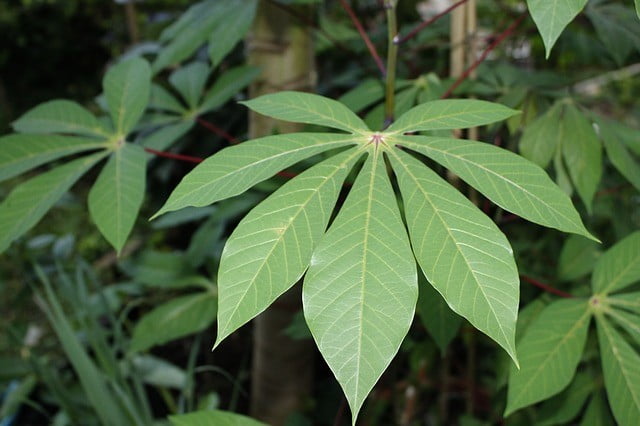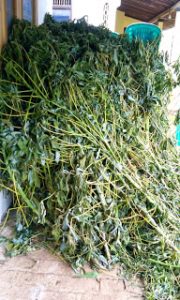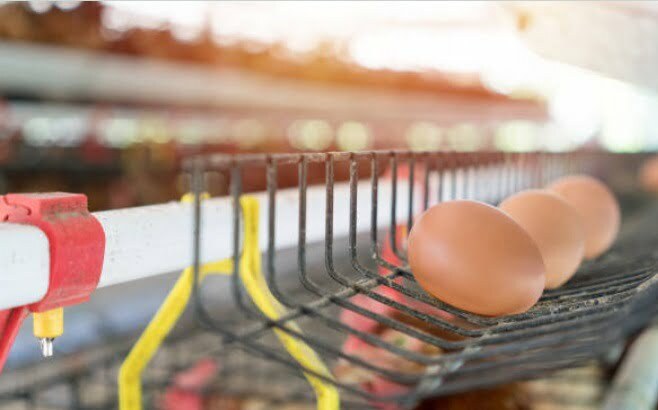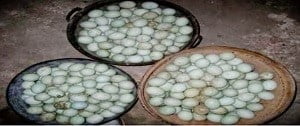In the previous article, we discussed about cassava leaves for goat feed which have high protein.
If you have not read it, please read it first. This article links, Cassava leaves high protein goat feed.
For this time, we will discuss about the further utilization of cassava leaves in goat farms.
Actually a lot of use from cassava leaves, both for humans, ruminant animals and poultry.
In order not to widen, the discussion focused on the utilization of cassava leaves in its use for goat farm.
In breeding, feed management is necessary. The purpose of animal feed management is so that the availability of goat feed can be continuous.
The continuity of the availability of goat feed can be met by planting their own forage.
Whether it’s done in your own land or lease.
Not all goat breeders originated from the availability of capital and land that support goat farms.
Get around that, then there is the need for extra activities to maintain the availability of goat feed.
Extra activity means “ngarit”, buying goat feed or using agricultural waste.
“Ngarit” is our local term. The meaning is to find the feed for livestock in the wild then take it home.
In our place, in the wild we can get grass and leaves feed.
An area with abundant agricultural waste can use it to meet the availability of goat feed.
For example, in the area of Lampung and the central district of Central Java, the majority of farming is cassava.
When the harvest season arrives, the cassava leaves are very abundant. If this opportunity is not put to good use, then it is futile.
How to use the cassava leaves can be done various ways. The trick, among others, is by drying, fermenting and silage.
Dried cassava leaves
Cassava leaves obtained from agricultural land are dried under the sun to dry.
After the cassava leaves dry, cassava leaves are crushed and stored into silos, drums or plastic.
Storage of dried cassava leaves should be done after the leaves become cold.
Cassava leaves are still hot, still remove water vapor.
If the cassava leaves are kept in hot condition, the steam will evaporate into the container where the cassava leaves are stored.
When the condition is cold, moisture will condense and make the cassava leaves moist again.
The condition of damp cassava leaves is not good for storage in the long term.
Silage of Cassava Leaves
Silage of cassava leaves is a feed that has high moisture content of fermentation.
In general, silage is made from grass plants such as maize, sorghum, cassava leaves and so forth.
In making silage, the use of plants not only on the leaves, but the stem can also be made silage.
The making of cassava leaf silage is intended to overcome the problem of availability of animal feed which amount is very abundant but only exist in a short time.
Silage of cassava leaves can be stored up to 6 months.
The process of making cassava leaves silage can reduce anti-nutrients in the feed, which can cause poisoning in goats.
In principle, the process of making cassava leaves silage is to store cassava leaves in a state without oxygen (O2) to stop the respiration and evaporation of plant cells.
The process of cassava silage leaves is to convert carbohydrates into lactic acid through anaerobic fermentation process, retaining the activity of enzymes and bacterial decomposition.
Step of making cassava leaves silage
Cassava leaves and young stems are chopped using a choper with a size of 1-3 cm, if no choper can use a machete.
The purpose of chopping is to shrink the size of the material so that it will minimize the air cavity when the silage making process.
Anaerobic atmosphere can be achieved better with a minimum of air cavities.
Put chopped cassava leaves into a plastic bag. When inserting cassava leaves, pressed until the air cavity to a minimum. The presence of air cavity will reduce the quality of the resulting silage.
Plastic bags do not leak. If leaking, it will cause poor quality silage and even the failure of the silage process.
In the leaky pastik will usually arise mushrooms, maggots and silage will clot, mucus and smell bad.
Plastic ties are tight. Store in a shaded place that is protected from the heat of the sun and rain.
After 7 days, silage can be given to livestock. Silage can be stored up to 6 months in a tightly sealed condition.
The finished silage is characterized by its distinctive scent, a brownish green color.
So post cassava leaves for goat feed, may be useful.
 JOYNIM FARM Goat Farming, Cattle Farm, Laying Hens, Quail Farm, Gardening
JOYNIM FARM Goat Farming, Cattle Farm, Laying Hens, Quail Farm, Gardening




